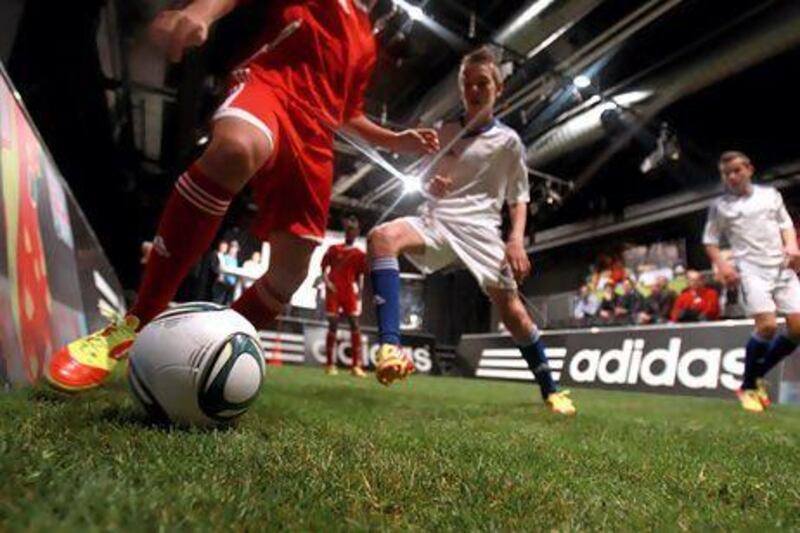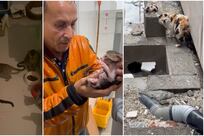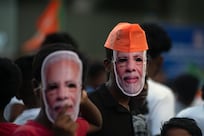Football fans have long wondered exactly how fast and how powerful their favourite players are on the field.
It turns out, some coaches, trainers and equipment technicians already know in real time, during every match.
Few fans have realised it, but some football players within the Major League Soccer (MLS) in the United States have been tucking a palm-sized device into the back of their sports shirts. The gadget, which is known as the miCoach Elite and is manufactured by the German sportswear giant adidas, then records data about a player's power, distance run and the rate at which they accelerate or decelerate. It also transmits live updates that get sent directly to a coach's iPad as they watch from the sidelines of a football field.
"From influencing in-game managerial decisions, such as substitutions and team tactics, to analysing trends to prevent overtraining and risk of injury, the technology will help maintain optimum levels of player performance week in, week out throughout the season," says adidas.
What is perhaps most interesting about this technology is that its roots trace back to a small start-up that has become somewhat of a digital brains trust at adidas, which is trying to push further into the so-called wearable technology sector.
This market includes a wide array of digital eyewear, bracelets and clip-on devices, some of which is considered infotainment and connect to the Web. Other products, including the miCoach line for consumers as well as the Elite offshoot for professional athletes, can track various health metrics.
Globally, wearable technology products generated US$750 million last year, although that is expected to grow at a rate of nearly 41 per cent annually through 2018, to $5.8 billion, according to a study released in June from Transparency Market Research.
It was a little less than a decade ago when a start-up based in Chadds Ford, Pennsylvania, just outside the city of Philadelphia, began tinkering around in wearable technologies that might be used in military or medical applications.
"Medical always used to be the [goal]," says Qaizar Hassonjee, a co-founder at Textronics, who is now the vice president of innovation for wearable sports electronics at adidas.
But the sports sector ultimately proved to be easier to get into.
Back then, after all, there was no Nike+ FuelBand (a fitness-tracking bracelet), Fitbit Zip (a clip-on wireless activity sensor) or any of the numerous competing technologies vying for consumer dollars today. So Textronics thought it would try releasing something different: a sports bra capable of monitoring a woman's heart rate.
"It was very comfortable, easy to use, washable," says Mr Hassonjee, who shared his company's story to an audience at the Wearable Technology Expo in New York last month.
"In fact, when we launched it, people were not aware of [the heart sensor] and used it as a sports bra."
As gimmicky as the product seemed to some, it certainly interested adidas, which acquired Textronics in 2008. Since then, Mr Hassonjee's team has focused on bringing smart textiles, or wearable technology, under its parent company's umbrella of offerings
Various health and fitness sensors designed for individuals have come out for prices ranging from less than $100 up to about $300, says Mr Hassonjee. But the miCoach Elite, which began a broad rollout this summer to professional football teams, costs about $100,000, depending on a team's relationship with adidas and how many of its players use the device.
Part of the significantly higher cost can be attributed to a base station, which is about the size of a 60cm by 90cm suitcase on wheels that can be rolled on to the field's sidelines and carries its own power system. This box is what receives and saves the data transmitted by the miCoach Elite that is tucked in a player's shirt and it also recharges the device once it runs out after eight hours
Data transmitted between the two devices can help coaches off the field by more accurately determining whether a player should be pushed further or given a break during training sessions, Mr Hassonjee says.
"Each and every team makes a decision in terms of how they manage the data," he adds.
To figure out what kinds of jerseys - and devices - players would be willing to throw on, executives from Textronics spent plenty of time consulting various teams.
"We looked at the shirts that the players had been wearing, or like to wear, and used that as a base to embed the sensors in there," says Mr Hassonjee.
"We did do a lot of work testing it and making sure it's comfortable and easy to use and does not obstruct them in any movement," he adds.
"It is important to satisfy the needs of the athlete, the coach, as well as the equipment manager to make sure it's taken care of well and used properly."
The technology obviously "had to look pretty cool, too, otherwise [male footballers] wouldn't want to wear it", says Mr Hassonjee. "They're not going to wear anything that resembles a sports bra."
In the end, Textronics did avoid incorporating certain elements into its final product. For example, it could have added a respiration feature but the garment would not have been as comfortable. Also, there were questions about how detailed and, ultimately, helpful the data would have been.
"Even with all the work that we have done with the data and the sensors the important thing is that the information that comes out is very critical and easy to use," says Mr Hassonjee.
Having the adidas brand behind Textronics has helped open doors during sales calls but there are still plenty of other hurdles to overcome.
For starters, in this era of so-called big data, some possible partners are simply growing tired of what could be seen as information overload.
"There are a lot of sensors and data," Mr Hassonjee acknowledges. "Nobody wants [only] more data; they want very relevant, simple, easy-to-use data."
But some sports governing bodies, including the Fédération Internationale de Football Association, or Fifa, the game's world governing body, do not permit bi-directional communication during a match, locking out the miCoach Elite except for, perhaps, certain exhibition games.
Meanwhile, demand from other sports, such as basketball, has been limited because the device requires global positioning system technology to track a player's distance and speed.
Yet, Mr Hassonjee says, Textronics is working on alternative methods of getting the miCoach Elite tucked into a greater number of sports jerseys.
"This is wearable tech," he says. "Right now it was designed mainly for training in terms of helping athletes get better but, as it evolves, there's a huge opportunity to go into other sports and the amateur level as well."
[ business@thenational.ae ]





